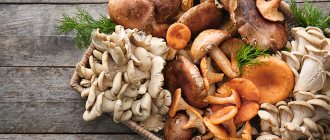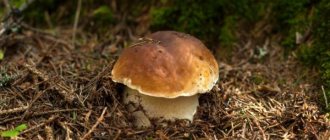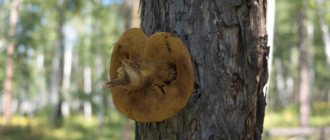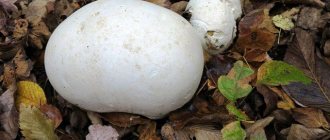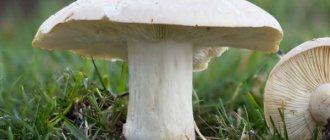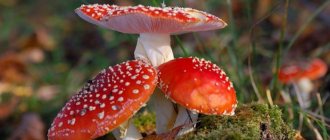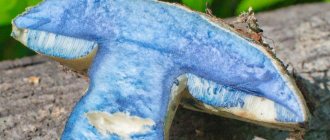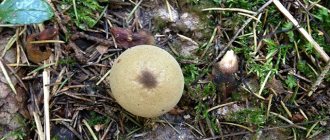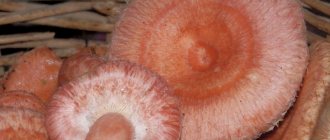Why are russulas called that?
The origin of the word “russula” dates back to the times of the Old Slavonic dialect. When deciphered, it sounds like raw food - a mushroom that can be eaten raw. However, russula was consumed even before the discovery of russulin.
Since ancient times, mushroom pickers have relied on their sense of smell, vision, and taste buds when harvesting. For example, podgrudok is eaten raw or in any other form. The possibility of consuming mycelium is determined by taste: if the cap is bitter, odorless, bright, sticky, then it cannot be eaten.
Russula is the opposite in all respects; the fruiting body has:
- sweetish aftertaste;
- characteristic aroma mixed with sweetness;
- the surface of the cap is rough to the touch;
- fragile structure of the cap and stalk of the mycelium.
The Latin name for russula is rússulus, which when translated means red or reddish, because most mushrooms from this family have a red cap. Most of the Russula family are edible, other species are slightly bitter, but the taste goes away after heat treatment or pickling.
Family Russulaceae
Russulas are lamellar mushrooms of the Russula family. They have fertile fleshy bodies. It is quite easy to recognize them in the forest by their bright caps of multi-colored flowers, which can reach from 2 to 20 centimeters in diameter. The caps can be bell-shaped, spherical or hemispherical. The inside of the mushroom is white. Russula caps are very fragile and break quickly, this reduces the economic importance of the mushroom. As they grow, the caps change shape and can become straight, funnel-shaped, or curled. And spores can have any shade: from white to yellow.
Russulas begin to appear in July. But massive growth is observed in August and September. So, is the russula mushroom edible or not? Most species of the family are edible. However, there are also those species that are not suitable for food due to their mild toxicity, unpleasant odor and taste. Of course, it is impossible to be poisoned by russula in the same way as, for example, by fly agarics, since they do not contain as much poison. But you should still be careful when picking mushrooms.
Russulas can be fried and pickled. They are included in the third category of edible mushroom species, which contains mushrooms that have average taste. Some experts classify them even in an even lower category, believing that they have no nutritional value.
Is it possible to eat russula mushrooms raw?
It is not recommended to taste or eat freshly harvested crops from various types of russula. You shouldn't do this in the forest either. They are eaten raw at the collection site only if the mushroom picker is absolutely sure that it belongs to the edible variety. The russulin contained in the mycelium was discovered quite recently, but it is scarce in other varieties of mycelium, so because of the bitter taste, the mushrooms are boiled and then used for various dishes. The enzyme makes them sweet, edible, and gives them flavor. There is no russulin in the poisonous mycelium at all, so any mycelium eaten will cause irritation of the mucous membranes, vomiting, and diarrhea.
Important! Regardless of whether russula belongs to the edibility group, the mushrooms are boiled or soaked in hot water for 15-30 minutes before use.
Healing properties and contraindications
Russulas are low in calories (100 grams of fresh product contains 19 calories), since they consist of 90% water and have a rich vitamin and mineral composition.
The benefits of forest gifts for the human body cannot be overestimated. Interestingly, in ancient times, mushrooms were used by folk healers to treat various ailments: frostbite, boils, headaches, psycho-emotional disorders.
The effect of russula on the human body:
- Supplied with vitamins, minerals, protein. Interestingly, to satisfy the body in proteins, it is enough to eat 150 - 200 grams of dried mushrooms per day. This property looks especially attractive to vegetarians and raw foodists who suffer from a lack of protein in their diet due to the exclusion of meat products from the menu.
- Strengthen the immune system and prevent cancer due to selenium content.
- They clean blood vessels, prevent the formation of cholesterol plaques, blood thickening, and the formation of blood clots, which cause the development of cardiovascular pathologies.
- They normalize metabolism, remove excess fluid from the body, and promote weight loss.
- Prevent emotional disorders, mental exhaustion, calm the nervous system.
- Improves the condition of teeth, nails, hair, skin, bones.
- Cleanses the stomach and intestines (adsorb harmful substances from the body).
Interestingly, mushroom juice is used externally in the fight against corns (keratinized skin on the feet). The safe daily dose of russula for a healthy adult is 150 grams. Be extremely careful when collecting forest products so as not to pick poisonous specimens.
Russula, like other types of mushrooms, belong to the category of difficult-to-digest foods. Despite the healing properties of the product, they are not recommended for use by people with acute inflammatory processes in the digestive system, impaired liver and heart function, with individual intolerance, children under 7 years of age, pregnant and lactating women.
What kind of russula can be eaten raw?
Scientists have identified only 32 edible species. Some of them are present in almost any forest in Russia. In many cases, mushroom pickers encounter the most common varieties of russula suitable for consumption:
- Blue-yellow. The mycelium has an unusual color - dark blue edges and a yellowish center of the cap, so this strange name for russula arouses interest. It is found in the forests of Europe, Asia, and Russia, and is valued for its unusual aftertaste in gourmet culinary dishes.
- Green - ordinary mycelium of pale gray color. The hat in the center has a greenish color. The mushroom is edible and not bitter. It grows and reproduces in mixed or deciduous forests, mainly adjacent to birch.
- Golden yellow or red russula. The unusual appearance is characterized by a memorable color and the smell of roses. The taste is sweetish, not bitter. Found in deciduous and rarely in coniferous forests. It is considered a delicacy in European cuisine.
- A variety of fork mushroom. Russula is eaten raw; it tastes similar to champignons. Lamellar mycelium is flexible and has a stem tapering towards the base. Grows in forests of any type, found on forest edges and berry meadows.
- Olive - the mycelium cap is dry and rough. Olive color often alarms mushroom pickers. For some time now, the fruiting body has been used as dry fiber for food supplements. Mycelium has a pleasant taste and smell and is found everywhere.
- Bolotnaya. Despite the name, it is very nutritious for the body and edible in any form. It has no taste, but has a pleasant fruity smell. This is a lamellar mushroom with a smooth red cap and white dense flesh. It can be found in swamps, next to a stream or a coniferous forest.
Why was russula called russula and in what form is it best to eat?
Since childhood, I was instilled with a love for mushrooms and now I am already an experienced mushroom picker. I remember when I was still little and spent the whole summer at the dacha, every morning I climbed over the fence into the forest to “get food.” Opposite our house there was a beautiful clearing, where almost every day I collected a colorful harvest of russula, differing not only in the color of the cap, but also in its shape and size. It was only as an adult that I learned that there are more than 150 species of these miracle mushrooms. Then I simply wondered why this mushroom has the same name, but at the same time they are not all similar to each other.
And I was always surprised by the self-explanatory name of this mushroom. And so, after many years, I decided to find out why russula was nicknamed russula?
It is believed that these mushrooms can be eaten directly raw. However, this statement is quite contradictory, since some types of russula are completely inedible and have an unbearably hot taste. One of them received the unattractive name “caustic russula” for this reason. But some russula even in their raw form have a pleasant sweetish nutty taste and, probably, they can be eaten, as they say, “straight from the garden,” although I would not recommend it.
Vladimir Soloukhin once spoke about russula: “So, can you eat this mushroom raw? Sometimes we tried it in childhood, bit off the edge, and then for a long time we could not wash out the terrible acrid bitterness in our mouths with river water. Wow, Russula!”
Indeed, some types of russula must be boiled before cooking, otherwise they will retain an acrid, bitter taste. However, it is worth noting that there are few such species.
It is also believed that russula got its name also because when salted, they quickly become ready for consumption, sometimes within a day, which is not enough for other mushrooms. That is, while still essentially fresh (raw), they will be suitable for inclusion in the menu.
Russulas have one significant drawback: the pulp is very brittle. Therefore, when collecting these mushrooms, special care is needed, and in order to bring them home safe and sound, virtuosity in handling both the mushrooms and the basket will not hurt.
Since russula is a fairly common mushroom that grows throughout the summer-autumn season, it is of particular value in the diet of a prepper. And this despite the fact that there are mushrooms that are nobler and tastier. But if you still need to look for other mushrooms, then russula can always be found in the forest spaces of our Motherland. The only thing you sometimes have to tinker with is getting them out of the grass so that the cap doesn’t break and the mushroom doesn’t turn into a solid mess.
As for the options for preparing russula, their variety leaves room for flights of fancy even for an inexperienced cook. They are eaten fried, boiled, stewed (tastier in sour cream), salted and pickled. Just before the main cooking procedure, it is better to pre-boil them for 5-7 minutes. Types that have a fresh taste can be cooked immediately, without prior boiling. It is believed that salted russula are the most delicious.
I would like to note that the first russula appear in June. But the real time of abundance is August-September. So hurry to the forest! Now is the time to enjoy this wonderful mushroom!
Tags: mushrooms, forest, names, September
What do raw russulas taste like?
Mushrooms are only called russula, but most types must first be determined for taste and edibility, then treated with boiling water. The taste of russula is valued for its unique aroma and nutrients. All these qualities are most clearly expressed in pickled mushrooms. The pulp and taste depend on the area where the mycelium grows, as well as on the presence of absorbed substances from the soil. Forest species are the most delicious - this is what mushroom pickers think, but mycelium grown on your own plot or in artificial conditions is more useful. After heat treatment, the taste does not disappear, sometimes the smell and aftertaste become more pronounced. The most common mycelium does not taste bitter, gives off a sweetish or mushroom taste, and often smells of ozone or grass.
Advice! If it is not possible to compare the real and false mushroom, you need to feel the cap of the fruiting body. Poisonous varieties are more slimy and sticky to the touch.
